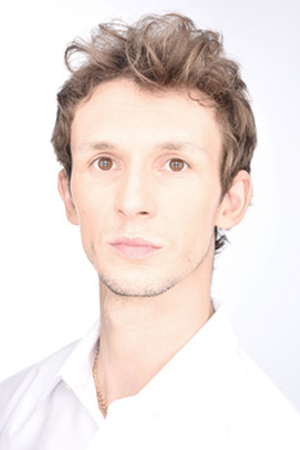
• Merited Artist of the Russian Federation (2021)
• He was voted The Best Dancer of the Year by the Italian Danza & Danza magazine (2019)
• Grand Prix at the International Ballet Festival Dance Open (2016)
• Recipient of the International Ballet Festival Dance Open Prize in Mister Virtuosity nomination (2014)
• Recipient of the Benois de la Danse prize (2011)
• Recipient of the Spirit of Dance prize in the category “Star” (Ballet magazine, 2011)
• Recipient of the special prize at the International Dance Competition in Seoul (2006)
• Prize-winner at the International Ballet Dancers’ Competition in Seoul (2004, 3rd prize)
Born in Barnaul. Graduated from Novosibirsk Choreographic College in 2003 (class of Alexander Shelemov). He joined the Universal Ballet Company under the direction of Oleg Vinogradov (Seoul, Republic of Korea) in 2003 and remained there until the year 2007. In 2007–2008, he was the principal with the Zurich Ballet (Switzerland). In 2008–2011, he was the principal with the K. S. Stanislavsky and Vl. I. Nemirovich-Danchenko Moscow Academic Music Theatre. In 2007-2011, he was a guest soloist with Novosibirsk State Academic Opera and Ballet Theatre. In the season 2011–2012 joined the Bolshoi ballet.
Repertoire includes:
La Sylphide (James), choreography by August Bournonville in the version by Johan Kobborg,
Giselle (Count Albrecht); choreography by Jean Coralli, Jules Perrot and Marius Petipa, revised version by Yuri Grigorovich,
La Bayadère (Solor), Raymonda (Jean de Brien), The Sleeping Beauty (Prince Désiré); choreography by Marius Petipa, revised version by Yuri Grigorovich,
Swan Lake (Prince Siegfried); choreography by Marius Petipa and Lev Ivanov, revised version by Yuri Grigorovich,
Don Quixote (Basilio); choreography by Marius Petipa, Alexander Gorsky in the version by Alexei Fadeyechev,
George Balanchine’s ballets Symphony in C (III. Allegro vivace), Apollon Musagète (Apollon Musagète), Jewels (Diamonds, Emeralds),
Etudes; choreography by Harald Lander,
Onegin (Lensky); choreography by John Cranko,
Nutcracker (Nutcracker-Prince); choreography by Yuri Grigorovich,
La Fille du Pharaon (Lord Wilson-Taor), Marco Spada (Prince Frederici); choreography by Pierre Lacotte,
Forgotten Land (Couple in White), choreography by Jiry Kylián,
Anna Karenina (Karenin), Lady of the Camellias (De Grieux); choreography by John Neumeier,
Kvartira; choreography by Mats Ek,
The Bright Stream (Petr), Romeo and Juliet (Romeo); choreography by Alexei Ratmansky,
Classical Symphony; choreography by Yuri Possokhov,
Gaîté Parisienne (Lover); choreography by Maurice Béjart,
Remanso; choreography by Nacho Duato,
The Taming of the Shrew (Lucentio); choreography by Jean-Christophe Maillot,
The Winter’s Tale (Leontes); choreography by Christopher Wheeldon,
Orlando (Elizabeth I/ Shelmerdine); choreography by Christian Spuck,
Artifact Suite; choreography by William Forsythe,
Dream of Dream; choreography by Jorma Elo.
As a guest soloist she performed with the Mariinsky Ballet, Mikhailovsky Theatre, Tokyo Ballet, Les Ballets de Monte Carlo, Vienna State Ballet, Teatro dell’Opera di Roma Ballet Company.
Information for July 2021